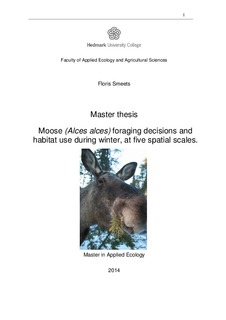| dc.description.abstract | 1. Forage availability is a strong tool for predicting large herbivore distribution and habitat use throughout different spatial scales. Yet, no large scale study has been executed where real biomass availability of palatable tree species was used as tool to explain moose browsing decisions and habitat use through different spatial scales.
2. In the boreal forest of southern Norway, I measured moose habitat use as the number of moose pellet groups, moose browsing as the quantity and proportion of biomass consumed and habitat characteristics at five spatial scales i.e. regional (N=1), landscape (N=3), large community (N=61), small community (N=976) and individual tree level (N=8038). I used quantity of biomass available, altitude, tree density, number of moose pellet groups, Feeding Site Attractiveness Value, intensity of old browsing, cutting classes and tree species as variables to explain moose browsing decisions and habitat selection through the different spatial scales.
3. The data, for the two largest spatial scales, were compared. Statistical analyses were run for the three smallest scales. I compared the change in the estimates of the variables in the full models between large community and small community scale. Additionally, for the three smallest scales, the best models were selected based on lowest AIC values. For the two smallest spatial scales, the best models predicting whether browsing occurred or not were also selected on lowest AIC values.
4. During the winter of 2011-2012, I found that moose selected cutting class 2 forest stands for foraging, which accounted for 53.35% of the available biomass. Here they consumed 80.47% of the measured browsed biomass. Cutting class 3, which accounted for 28.09% of the available biomass, was mainly selected for cover but minimally for foraging. Further, habitat use decreased with an increase in altitude. Moose increased usage of large patches with an increase in quantity of biomass available and increase in tree densities. For small communities, previous browsing was also a significant predictor, i.e. moose selected for small patches with higher quantity of biomass available which had been browsed in previous years, within the selected large patches.
5. Species which were rare on regional and landscape scale, suffered higher browsing pressure than those which were abundant. Scots pine was the main food source, accounting for 84.74% of the measured consumed biomass. Quantity and proportion of biomass browsed from small and large patches containing rare species, did not significantly differ from those without rare species. With an increase in previous browsing in small patches and on individual trees, the chance of being browsed increased. Both large and small communities showed an increase in quantity and proportion of biomass browsed with an increase in previous browsing. Yet, on individual tree level, previous browsing failed to explain quantity and proportion of biomass browsed.
6. To be able to reduce moose browsing pressure on young Scots pine stands, I advise increasing the forage availability in cutting class 2 stands and reducing the wintering moose densities. Creating disturbance by increasing predation risk could be an effective tool in reducing browsing pressure on young forest stands, as has been proven in Yellowstone National Park. However, as large carnivores and their existence in Norway are the base of ongoing conflicts, this potential solution may not be considered at the present time. | nb_NO |
